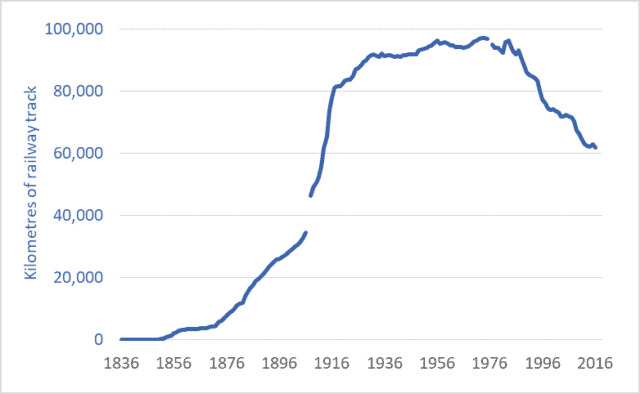One kilometre of oil pipeline contains the same amount of steel as two kilometres of railway track.* The proposed Trans Mountain pipeline expansion will, if it goes ahead, consume enough steel to build nearly 2,000 kms of new passenger rail track. The Keystone XL project would consume enough steel to build nearly 4,000 kms of track. And the now-cancelled Energy East pipeline would have required as much steel as 10,000 kms of track. (For an overview of proposed pipelines, see this CAPP publication.)
With these facts in mind, Canadians (and Americans) should consider our options and priorities. There’s tremendous pressure to build new pipelines. Building them, proponents claim, will result in jobs and economic development. But if we’re going to spend billions of dollars, lay down millions of tonnes of steel, and consume millions of person-hours of labour, should we be building soon-to-be-obsolete infrastructure to transport climate-destabilizing fossil fuels? Or should we take the opportunity to create even more jobs building a zero-emission twenty-first century transportation network for Canada and North America? Admittedly, the economics of passenger rail are different than those of pipelines; building a passenger rail system is not simply a matter of laying down steel rails. But for reasons detailed below, limiting global warming probably makes significant investments in passenger rail inevitable.
The graph above shows the total length of the Canadian railway network. The time-frame is the past 180 years: 1836 to 2016. Between 1880 and 1918, Canada built nearly 70,000 kms of railway track—nearly 2,000 kms per year, using tools and machinery that were crude by modern standards, and at a time when the nation and its citizens were poor, compared to today. In the middle and latter decades of the twentieth century, tens of thousands of kms of track were upgraded to accommodate heavier loads.
The length of track in the Canadian railway system peaked in the 1980s. Recent decades have seen the network contract. About a third of Canadian rail lines have been torn up and melted down over the past three-and-a-half decades. Passenger rail utilization in recent years has fallen to levels not seen since the 1800s—down almost 90 percent from its 1940s peak, despite a doubling of the Canadian population. Indeed, ridership on Via Rail is half of what it was as recently as 1989.
Contrast China. In just one decade, that nation has built 25,000 miles of high-speed passenger rail lines. Trains routinely operate at speeds in excess of 300 km/h. Many of those trains were designed and built by Canada’s Bombardier. China plans to build an additional 13,000 kms of high-speed passenger lines in the next seven years.
Japan’s “bullet trains” began running more than 50 years ago. The Japanese high-speed rail network now exceeds 2,700 kms, with trains reaching speeds of 320 km/h.
Saudi Arabia, Poland, Turkey, and Morocco all have high-speed lines, as do more than a dozen nations in Europe. Uzbekistan—with a GDP one-twentieth that of Canada’s—has built 600 kms of high-speed rail line and has trains operating at 250 km/h.
The construction of Canadian and North American passenger rail networks is probably inevitable. As part of an international effort to hold global temperature increases below 2 degrees C, Canada has committed to reduce greenhouse gas (GHG) emissions emission by 30 percent by 2030—now less than 12 years away. Emissions reductions must continue after 2030, reaching 50 to 60 percent in little more than a generation. Emission reductions of this magnitude require an end to routine air travel. Aircraft may still be needed for trans-oceanic travel, but within continents long-distance travel will have to take place using zero-emission vehicles: electric cars or buses for shorter journeys, and electrified passenger trains for longer ones.
This isn’t bad news. Trains can transport passengers from city-centre to city-centre, eliminating long drives to and from airports. Trains do not require time-consuming airport security screenings. These factors, combined with high speeds, mean that for many trips, the total travel time is less for trains than for planes. And because trains have more leg-room and often include observation cars, restaurants, and lounges, they are much more comfortable, enjoyable, and social. For some long journeys where it is not cost-effective to build high-speed rail lines, European-style sleeper trains can provide comfortable, convenient overnight transport. In other cases, medium-speed trains (traveling 150 to 200 km/h) may be the most cost-effective option.
Canada must embrace the inevitable: air travel must be cut by 90 percent; and fast, comfortable, zero-emission trains must take the place of the planes. Maybe we can build thousands of kms of passenger rail lines and thousands of kms of pipelines. But given the gravity and menace of the climate crisis and given the rapidly approaching deadlines to meet our emission-reduction commitments, it isn’t hard to see which should be our priority.
*For example, Kinder Morgan’s Trans Mountain pipeline would be made up primarily of 36” pipe (914mm) with a 0.465 wall thickness (11.8 mm). This pipe weighs 262 kgs/m. Rails for high-speed trains and other demanding applications often weigh 60 kgs/m. As two rails are needed, this means 120 kgs/m—half the weight of a comparable length of pipeline.
Graph sources:
Urquhart and Buckley, 1965, Historical Statistics of Canada.
Leacy, Urquhart, and Buckley, 1983, Historical Statistics of Canada, 2nd Ed.
Stats. Can., Various years, Railway Transport in Canada: General Statistics.
Stats. Can., CANSIM Table 404-0010

